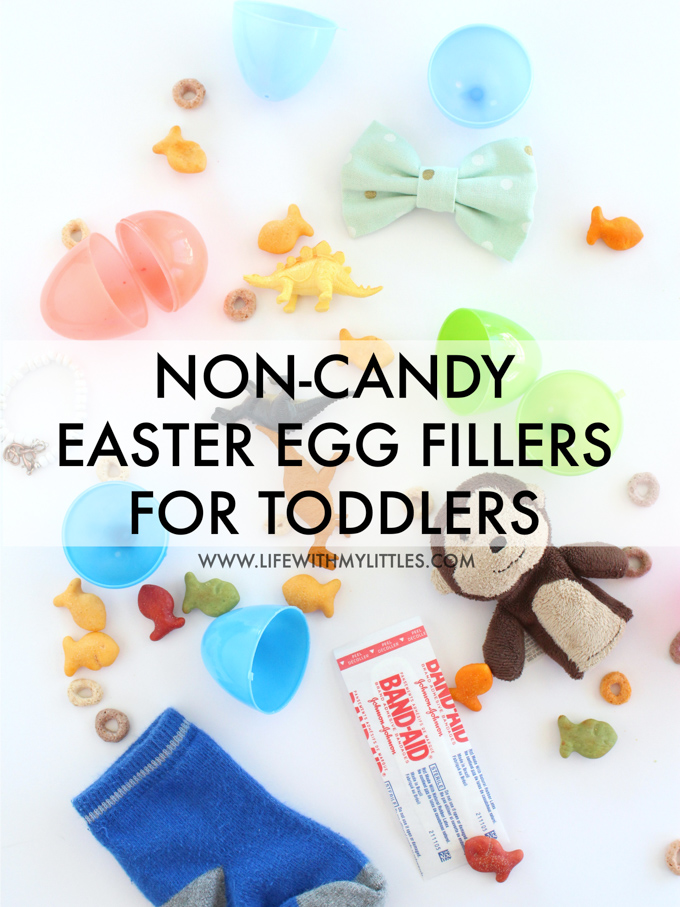What do you put in toddler Easter eggs? Instead of loading up on candy, try non-candy easter egg ideas like small toys, healthy treats, or fun activity prompts. Filling Easter eggs for toddlers can be a fun and creative way to celebrate the holiday while keeping things age-appropriate and safe. This article offers a wealth of easter egg prize ideas for kids under 3, ensuring a memorable and enjoyable Easter experience for your little ones.

Image Source: www.lifewithmylittles.com
Beyond the Chocolate Bunny: Creative Toddler Easter Egg Fillers
Easter is a joyous time for families, and the anticipation of opening those colorful eggs is a highlight for many children. However, for toddlers, excessive candy can be problematic. This guide explores easter egg alternatives for candy and safe easter egg fillers for babies, providing diverse and engaging options that are both fun and developmentally appropriate.
Why Ditch the Candy Overload?
Before diving into specific filler ideas, it’s essential to consider why reducing or eliminating candy from your toddler’s Easter egg hunt is beneficial.
- Dental Health: Sugar contributes to tooth decay. Limiting sugar intake is crucial for maintaining healthy teeth.
- Balanced Diet: Filling up on candy can displace more nutritious foods, potentially hindering your child’s nutritional intake.
- Behavioral Issues: Excessive sugar consumption can lead to hyperactivity, mood swings, and difficulty focusing.
- Allergies and Sensitivities: Many candies contain common allergens, such as nuts, dairy, and soy, which can trigger allergic reactions in sensitive children.
Toy Treasures: Small Easter Egg Gifts for Toddlers
Easter egg toys for toddlers are a fantastic way to add excitement and play value to the Easter egg hunt. Choose toys that are appropriately sized and safe for your child’s age. Avoid small parts that could pose a choking hazard.
Best Toy Filler Ideas
- Mini Figurines: Small animal figurines, cars, or popular cartoon characters.
- Building Blocks: Individual LEGO bricks (Duplo size for younger toddlers) or similar construction toys.
- Bath Toys: Tiny rubber ducks, squirt toys, or floating shapes.
- Stickers: Fun and colorful stickers of various shapes and themes.
- Temporary Tattoos: Simple, age-appropriate temporary tattoos.
- Finger Puppets: Small finger puppets featuring animals or characters.
- Small Musical Instruments: Mini whistles, kazoos, or maracas (ensure they are safe and durable).
- Bubbles: Small, travel-sized bubble containers.
Safety Considerations for Toy Fillers
- Size: Ensure toys are large enough to prevent choking. A good rule of thumb is to avoid anything smaller than a golf ball.
- Material: Choose durable, non-toxic materials. Avoid toys made from brittle plastic that could break into sharp pieces.
- Age Appropriateness: Always check the manufacturer’s age recommendations.
- No Small Parts: Ensure the toys do not have small, detachable parts that could be a choking hazard.
- Inspect Regularly: Check toys for damage and replace them if they are broken or worn.
Healthy Easter Egg Treats: Nutritious and Delicious
Healthy easter egg treats can be a fantastic alternative to candy, providing essential nutrients while still being enjoyable for your toddler. These options offer a healthier way to celebrate Easter.
Nutritious Filler Ideas
- Dried Fruit: Raisins, cranberries, or chopped dried apricots. (Cut them into smaller pieces for very young toddlers).
- Fruit Snacks: Organic fruit snacks with no added sugar.
- Puffs and Cereal: Small portions of whole-grain puffs or cereal.
- Cheese Crackers: Individually wrapped cheese crackers.
- Yogurt-Covered Raisins: A healthier alternative to chocolate-covered treats.
- Mini Rice Cakes: Unflavored or lightly flavored mini rice cakes.
- Homemade Treats: Small, baked goods like mini muffins made with whole wheat flour and natural sweeteners.
Tips for Choosing Healthy Treats
- Read Labels Carefully: Check for added sugar, artificial sweeteners, and unhealthy fats.
- Choose Whole Grains: Opt for whole-grain snacks over refined grains.
- Prioritize Natural Sweeteners: Use natural sweeteners like fruit puree or honey sparingly.
- Consider Allergies: Be mindful of any allergies or dietary restrictions your child may have.
Easter Egg Activity Ideas for Toddlers: Fun Beyond the Hunt
Easter egg activity ideas for toddlers can add an educational and creative element to the Easter celebration. Instead of just filling eggs with items, incorporate activities that will engage your child’s mind and imagination.
Creative Activity Prompts
- Coloring Pages: Roll up small coloring pages and include a crayon in the egg.
- Puzzle Pieces: Place individual puzzle pieces in different eggs, encouraging your child to find all the pieces to complete the puzzle.
- Seed Packets: Include small packets of flower or vegetable seeds and encourage your child to plant them.
- “Make a Face” Stickers: Provide blank face templates with stickers to create silly faces.
- Drawing Prompts: Write simple drawing prompts on small pieces of paper (e.g., “Draw a flower,” “Draw a house”).
- Story Starters: Include short story starters to spark your child’s imagination.
- Scavenger Hunt Clues: Write clues on small pieces of paper that lead to another egg or a larger prize.
- Movement Cards: Include simple movement prompts like “Hop like a bunny,” “Wiggle like a worm,” or “Flap your arms like a bird.”
Educational Activity Ideas
- Letter or Number Recognition: Place small letter or number magnets or foam pieces in the eggs.
- Shape Sorting: Include different shaped objects (e.g., a small square, circle, triangle) and have your child sort them into the corresponding shape sorter.
- Color Matching: Fill eggs with objects of different colors and have your child match them to the corresponding color.
- Counting Activities: Place small objects like beads or pom-poms in the eggs and have your child count them.
Safe Easter Egg Fillers for Babies: Considerations for the Youngest Egg Hunters
For babies participating in their first Easter egg hunt, prioritizing safety is paramount. Ensure all easter egg prize ideas for kids under 3 are large enough to avoid choking hazards and made from non-toxic materials.
Safe Filler Ideas for Babies
- Soft Fabric Toys: Small, soft plush toys or fabric blocks.
- Teethers: Age-appropriate teethers made from BPA-free materials.
- Rattles: Small rattles that are easy to grip and shake.
- Crinkle Toys: Crinkle toys that make a stimulating sound when touched.
- Board Book Pages: Cut pages from a sturdy board book and place one page in each egg.
- Silicone Spoons: Soft silicone spoons for feeding.
- Washcloths: Rolled-up, soft washcloths.
Important Safety Tips for Babies
- Supervision: Always supervise babies during the Easter egg hunt.
- Large Eggs: Use larger eggs that are more difficult for babies to swallow.
- No Small Parts: Avoid any fillers with small, detachable parts.
- Cleanliness: Ensure all fillers are clean and sanitized.
- Choking Hazards: Be extra vigilant about potential choking hazards.
Age-Appropriate Easter Egg Stuffers: Tailoring Fillers to Developmental Stages
Choosing age-appropriate easter egg stuffers is crucial for ensuring that the Easter egg hunt is both fun and safe for children of all ages. Tailor the fillers to match the developmental stage of each child participating.
Toddler (1-3 years)
- Focus: Large, safe toys; simple activities; healthy snacks.
- Examples: Mini figurines, Duplo blocks, fruit snacks, coloring pages, rattles, soft toys.
Preschoolers (3-5 years)
- Focus: More complex toys, educational activities, small treats.
- Examples: Puzzles, small cars, stickers, temporary tattoos, seeds, letter magnets, dried fruit.
School-Aged Children (6+ years)
- Focus: Creative projects, challenging activities, small prizes.
- Examples: Art supplies, craft kits, small games, books, money, candy.
Non-Candy Easter Egg Ideas: Stepping Away from Sugar
Exploring non-candy easter egg ideas can transform your Easter egg hunt into a celebration of creativity, learning, and healthy fun.
Alternative Filler Options
- Art Supplies: Crayons, markers, paintbrushes, small watercolor palettes.
- Craft Supplies: Pom-poms, googly eyes, pipe cleaners, beads.
- Stationery: Mini notebooks, erasers, pencils, sharpeners.
- Hair Accessories: Hair clips, headbands, hair ties.
- Small Books: Miniature board books or single pages from a larger book.
- Personalized Items: Small items with your child’s name on them (e.g., stickers, keychains).
- Coupons for Activities: “Coupon” for a trip to the park, a movie night, or a special activity with mom or dad.
Maximizing the Fun: Tips for a Successful Toddler Easter Egg Hunt
Planning a successful toddler Easter egg hunt involves careful consideration of safety, engagement, and age-appropriateness. Here are some tips to ensure a fun and memorable experience for your little ones:
- Location: Choose a safe and age-appropriate location. Avoid areas with hazards like stairs, sharp objects, or water.
- Egg Placement: Place eggs in easily accessible locations. Avoid hiding them too well, as toddlers can become frustrated.
- Egg Variety: Use a mix of different colored eggs to add visual appeal.
- Supervision: Supervise the hunt closely to ensure children are safe and having fun.
- Limit the Number of Eggs: Avoid overwhelming toddlers with too many eggs. A smaller number of eggs can be more manageable and enjoyable.
- Equal Opportunity: Ensure that each child has an equal opportunity to find eggs. Consider assigning each child a specific color of egg to find.
- Prizes for Everyone: Have a small prize for each child at the end of the hunt, regardless of how many eggs they found. This promotes a sense of fairness and inclusivity.
- Make it Themed: Consider a themed egg hunt, such as a farm animal theme or a superhero theme.
- Keep it Short and Sweet: Toddlers have short attention spans. Keep the hunt relatively short to avoid boredom or frustration.
- Capture the Memories: Take plenty of pictures and videos to capture the fun and excitement of the Easter egg hunt.
Table: Safe and Unsafe Easter Egg Fillers for Toddlers
| Filler Type | Safe | Unsafe |
|---|---|---|
| Toys | Mini figurines (larger than a golf ball), Duplo blocks, soft toys, bath toys, stickers | Small LEGO pieces, marbles, balloons, toys with small detachable parts, sharp or brittle toys |
| Treats | Dried fruit (cut into small pieces), fruit snacks (no added sugar), puffs, cereal | Hard candies, lollipops, gum, nuts, popcorn, chocolate-covered nuts |
| Activities | Coloring pages, puzzle pieces (large), seed packets, drawing prompts | Small beads, glitter, paint, markers with removable caps |
| Baby-Specific | Soft fabric toys, teethers (BPA-free), rattles, crinkle toys | Coins, buttons, magnets, small batteries, any item smaller than 1.75 inches |
Frequently Asked Questions (FAQ)
-
What is the best age to start an Easter egg hunt?
The best age to start an Easter egg hunt is around 18 months to 2 years old. At this age, toddlers can typically walk or crawl, follow simple instructions, and understand the concept of finding hidden objects.
-
Can I use plastic Easter eggs for babies?
Yes, you can use plastic Easter eggs for babies, but ensure they are large and sturdy to prevent choking hazards. Always supervise babies closely during the hunt.
-
What are some easter egg alternatives for candy for children with allergies?
Safe alternatives include stickers, small toys, crayons, or homemade treats that are free of the allergen. Always double-check labels and ingredients to ensure they are safe for your child.
-
How many eggs should I hide for a toddler?
Start with a small number, such as 5-10 eggs. Too many eggs can be overwhelming for toddlers. Adjust the number based on your child’s attention span and interest.
-
What should I do if my toddler tries to eat the plastic Easter egg?
Immediately remove the egg from your toddler’s reach. Explain that the egg is not for eating and offer a safe alternative, such as a toy or snack.

Clark Lubowitz is a parenting expert with over 10 years of experience in toddler care and child development. Holding a degree in Early Childhood Education, he specializes in blending modern technology with parenting, offering expert advice on the best toddler gadgets. Through his work on ToddlerAwesome.com, Clark provides valuable insights to help parents make informed decisions for their little ones.
